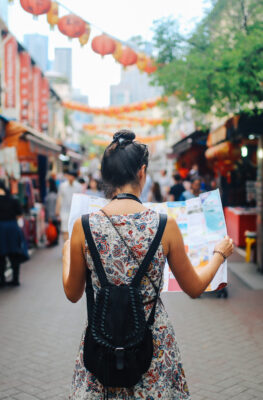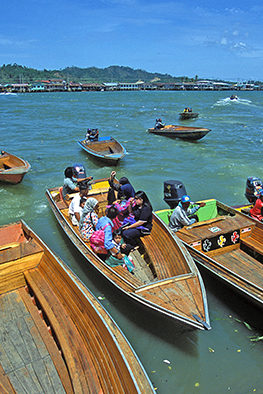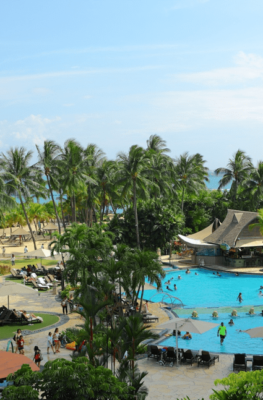Published on August 22, 2023
The Southeast Asian nation of Indonesia has an unparalleled sense of identity and countless cultural wonders. Consisting of over 17,000 islands, thousands of ethnic groups, and more than 700 languages, Indonesia is a land rich in diversity and a beautiful culture defined by its national motto: “Bhinneka Tunggal Ika,” an Old Javanese phrase that can be translated to “unity in diversity.”
The coalescence of culture throughout Indonesia’s centuries of history makes it a fascinating destination, as it is home to everything from millennia-old Hindu and Buddhist temples to autonomous farmlands and archaeological wonders.
No matter where in the archipelago of Indonesia you choose, you will be able to immerse yourself in the country’s rich culture. From visiting the spectacular ruins of early empires to watching traditional Indonesian art performances, there is no shortage of ways to experience Indonesian culture.
Continue reading to learn more about the cultural wonders of Indonesia.
Bali’s Subak System
Rice terraces in Bali, Indonesia | Visit Southeast Asia
Besides incredible beaches, the famed Indonesian island of Bali is known for its unique water management system, Subak. The island’s long history was once largely agrarian, which gave rise to the sustainable irrigation system of Subak that nourished Bali’s verdant rice paddies. The system is characterized by forest-protected water supplies, terracing, canals, and temples, and it dates back to as early as the 9th century; it allowed Bali to become the dense, productive island it is today. Subak is also singular for its emphasis and reliance on the spiritual connection between the land, the people, and God.
Nowadays, Bali’s Subak system is spread across 49,000 acres of land in Bali, comprised of five rice terraces and several royal water temples. The entire landscape is a tribute to Indonesia’s spiritual and agricultural history and culture; beyond its significance, Subak also makes for a magnificent landscape. For those visiting Bali, a walk along the rice fields and lush hills and a stop or two in the temples built for the Subak system is an absolute must.
Wayang Puppet Theatre
A man holding Wayang puppets | Visit Southeast Asia
An ancient Javanese art, Wayang puppet theatre is a traditional performance that exemplifies the storytelling spirit of humankind. ‘Wayang’ literally means shadow, though this puppetry performance is commonly watched from both sides of the screen. It is unique for its elaborate, intricate puppets, symbolism, and complex musical pairings, and it originated in the Indonesian region of Java sometime in the first millennium CE. In modern Indonesian culture, Wayang performances are usually used for ritual events and celebrations, such as weddings, Indonesian Independence Day, prayer rituals, and more.
This indigenous puppet tradition represents Indonesia’s iconic artistic heritage and stories; from its carefully constructed leather puppets to the ancient tales being told, Wayang performances are an unforgettable experience. They are most common in Central and East Java, though visitors can also find performances in Bali and elsewhere.
Ujung Kulon National Park
Endangered rhinoceroses at Ujung Kulon National Park | Visit Southeast Asia
Located at the westernmost point of Java, Ujung Kulon National Park highlights Indonesia’s remarkable biodiversity and marvellous geological formations. This lowland forest stretches over 600 square kilometres; its protected status results from an 1883 volcanic eruption that caused a tsunami that cleared the entire area. The area was never fully repopulated and became a nature reserve in the early 20th century. The park is famed for its untouched flora and fauna — particularly the highly endangered one-horned Javan rhinoceros — its pristine waterfront, coral reefs, and its serene state.
Ujung Kulon National Park is a portal to the past, to a time before humans walked the earth. Therefore, it is a major cultural and natural attraction — it provides an authentic glimpse into Indonesia’s origins.
Sangiran Early Man Site
A sculpture of Java Man at Sangiran | Visit Southeast Asia
Located in Central Java, the Sangiran Early Man Site is an archaeological wonder. It is one of the most fruitful excavating sites for early hominid fossils; the region has contributed an incalculable amount to the scientific understanding of early human evolution. Nearly a century ago, this 56-kilometre region gained prominence when a series of homo erectus specimens were discovered there. More than sixty fossils have been uncovered at Sangiran since, dating back millions of years, making the region a scientifically enthralling destination.
A museum marking the archaeological significance of Sangiran opened in 2011. It is set to have four sites scattered throughout the area; these will be the main museum/visitor centre, an exploration of the discovery of Sangiran, an exhibit about the fossils themselves, and an introduction to the latest scientific efforts. The main museum gives an overview of the types and significance of the fossils found in Sangiran, along with a guide to biological and geological research into the area. Anyone interested in the earliest inception of human culture will be fascinated by the Sangiran Early Man Site.
Prambanan Temple
The Prambanan Temple complex | Visit Southeast Asia
Dating back to the ninth century, the Hindu temple of Prambanan is an awe-inspiring sight. It is Southeast Asia’s second-largest Hindu temple and Indonesia’s largest. Classic Hindu and Java architecture have become synonymous with Prambanan’s character and design. The complex once included 240 different buildings, with the tallest measuring 47 meters. Inside, the temple features engravings that illustrate the Hindu epic the Ramayana, a sprawling, iconic story of good and evil. Inside and out, Prambanan is a masterpiece of Javanese art and history.
Located in southern Java, Prambanan is conveniently located for a visit for anyone already on the island. It is a 45-minute drive from the city of Yogyakarta and is open daily to visitors. This grand, resplendent tribute to Indonesia’s religious history is well worth visiting for its cultural significance and architectural beauty.
From ancient puppetry traditions to architecturally significant Hindu temples, Indonesia offers a wealth of cultural wonders to explore. The country’s thousands of islands are immersive, unique, and unforgettable — truly a destination for the most discerning travellers.
Finish planning your trip to Indonesia with the help of Visit Southeast Asia.






